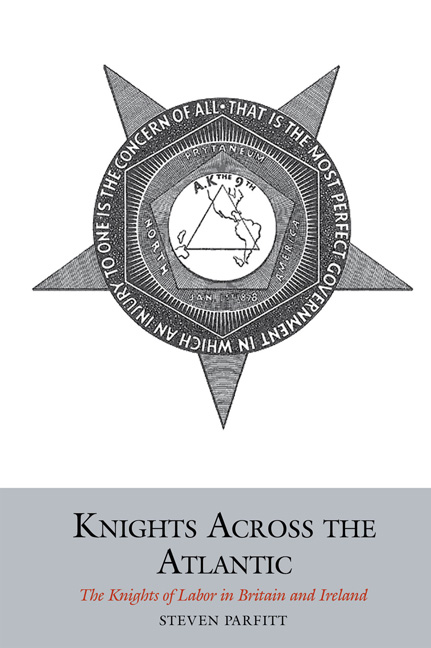Book contents
- Frontmatter
- Contents
- Acknowledgements
- Introduction: The World of the Knights of Labor
- 1 Origins
- 2 The Rise of a Transnational Movement
- 3 Organisation, Culture and Gender
- 4 The Knights in Industry
- 5 The Knights and Politics
- 6 The Knights and the Unions
- 7 The Fall of a Transnational Movement
- Conclusion: The Knights of Labor in Britain and Ireland
- Appendix: List of Known Assemblies of the Knights of Labor in England, Scotland, Wales and Ireland
- Bibliography
- Index
Introduction: The World of the Knights of Labor
- Frontmatter
- Contents
- Acknowledgements
- Introduction: The World of the Knights of Labor
- 1 Origins
- 2 The Rise of a Transnational Movement
- 3 Organisation, Culture and Gender
- 4 The Knights in Industry
- 5 The Knights and Politics
- 6 The Knights and the Unions
- 7 The Fall of a Transnational Movement
- Conclusion: The Knights of Labor in Britain and Ireland
- Appendix: List of Known Assemblies of the Knights of Labor in England, Scotland, Wales and Ireland
- Bibliography
- Index
Summary
On 9 December 1869, the members of the Garment Cutters’ Association of Philadelphia met to dissolve their organisation and divide its funds amongst themselves. After that meeting ended, some of them convened elsewhere to create a new, secret association. Nine men, joined by five more two days later, founded the first assembly or branch of the Noble and Holy Order of the Knights of Labor, although they only adopted that name on 28 December. The leading spirit behind that new order, Uriah Stephens, a man trained for the Baptist ministry before economic circumstances forced him to seek work in the garment trades, designed the Knights of Labor along the lines of a fraternal order with an elaborate ritual based on Freemasonry. The Knights kept their name and existence hidden from the public, even from the workers they sounded out as members. They announced their meetings in a cryptic code scrawled on the walls of public buildings. From these unlikely beginnings the Knights of Labor became one of the great social movements of nineteenth-century American history.
The Knights grew slowly during the 1870s. That decade was marked by the Panic of 1873, a global financial crisis that left economic depression in its wake, and by the Great Uprising of 1877, when the first nationwide railroad strike in American history took place and in some cities and acquired the feel of an armed struggle between workers, employers, local police and state militias. The Knights were only marginally involved in these battles and in 1878, at their first General Assembly, or national convention, they mustered around 10,000 members. As the trade unions succumbed to depressed economic conditions or to the counter-attacks of employers after the Great Uprising, the Knights moved slowly, at first, into the spaces they left behind.
They exploded onto the American social and political scene in the 1880s. From 50,000 members in 1883, 70,000 in 1884 and 100,000 in 1885, the Knights of Labor approached the staggering figure of 1 million members in the early months of 1886. In that year, known to historians as the Great Upheaval, American workers struck in unprecedented numbers, formed numerous labour parties that contested and often won elections, and flocked to labour organisations, whether the Knights or the trade unions, in their hundreds of thousands.
- Type
- Chapter
- Information
- Knights Across the AtlanticThe Knights of Labor in Britain and Ireland, pp. 1 - 19Publisher: Liverpool University PressPrint publication year: 2016



